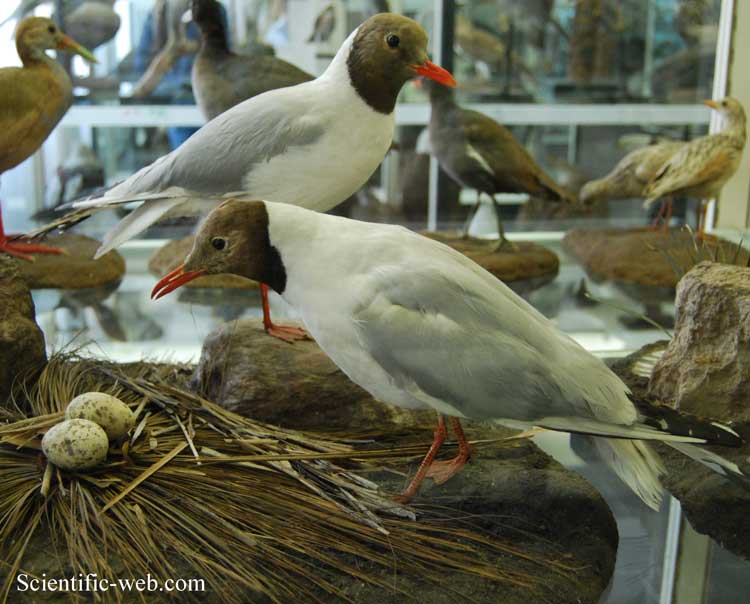
Larus ridibundus , Photo: Michael Lahanas
Cladus: Eukaryota
Supergroup: Opisthokonta
Regnum: Animalia
Subregnum: Eumetazoa
Cladus: Bilateria
Cladus: Nephrozoa
Cladus: Deuterostomia
Phylum: Chordata
Subphylum: Vertebrata
Infraphylum: Gnathostomata
Superclassis: Tetrapoda
Classis: Aves
Subclassis: Carinatae
Infraclassis: Neornithes
Parvclassis: Neognathae
Ordo: Charadriiformes
Subordo: Lari
Familia: Laridae
Subfamilia: Larinae
Genus: Larus
Species: L. ridibundus
Name
* Larus ridibundus Linnaeus, 1766
Vernacular names
Internationalization
Български: Речна чайка
Català: Gavina riallera
Česky: Racek chechtavý
Cymraeg: Gwylan Benddu
Dansk: Hættemåge
Deutsch: Lachmöwe
Ελληνικά: Καστανοκέφαλος Γλάρος
English: Black-headed Gull
Esperanto: Ridmevo
Español: Gaviota Reidora
Eesti: Naerukajakas
Français: Mouette rieuse
Frysk: Kob
Galego: Gaivota chorona
Italiano: Gabbiano comune
日本語: ユリカモメ
한국어: 붉은부리갈매기
Lietuvių: Rudagalvis kiras
Latviešu: Lielais ķīris
Nederlands: Kokmeeuw
Norsk (nynorsk): Hettemåse
Norsk (bokmål): Hettemåke
Polski: Mewa śmieszka
Português: Guincho-comum
Slovenčina: Čajka smejivá
Suomi: Naurulokki
Svenska: Skrattmås
Türkçe: Karabaş martı
中文: 红嘴鸥
The Black-headed Gull (Chroicocephalus ridibundus) is a small gull which breeds in much of Europe and Asia, and also in coastal eastern Canada. Most of the population is migratory, wintering further south, but some birds in the milder westernmost areas of Europe are resident. Some birds will also spend the winter in northeastern North America, where it was formerly known as the Common Black-headed Gull. As is the case with many gulls, it had previously been placed in the genus Larus.
This gull is 38–44 cm (15-17½ in) long with a 94–105 cm (37–41 in) wingspan. In flight, the white leading edge to the wing is a good field mark. The summer adult has a chocolate-brown head (not black, despite the name), pale grey body, black tips to the primary wing feathers, and red bill and legs. The hood is lost in winter, leaving just dark vertical streaks. This is a noisy species, especially in colonies, with a familiar "kree-ar" call. Its scientific name means "laughing gull".
It breeds in colonies in large reedbeds or marshes, or on islands in lakes, nesting on the ground. Like most gulls, it is highly gregarious in winter, both when feeding or in evening roosts. It is not a pelagic species and is rarely seen at sea far from coasts.
The Black-headed Gull is a bold and opportunist feeder and will eat insects, fish, seeds, worms, scraps and carrion in towns, or take invertebrates in ploughed fields with equal relish.
This species takes two years to reach maturity. First-year birds have a black terminal tail band, more dark areas in the wings, and, in summer, a less fully developed dark hood. Like most gulls, Black-headed Gulls are long-lived birds, with a maximum age of 63 years recorded in the wild.[2]
The Black-headed Gull is the prefectural bird of Tokyo and the Yurikamome mass transit system is named after it.
In popular culture
* Kehaar from Watership Down
Uses
The eggs of the black headed gull are considered a delicacy by some in the UK and are eaten hard boiled.[3][4]
Australian discovery
In the 1990s, local Broome birder Brian Kane saw a strange species of bird while trawling the local sewer ponds. Upon seeing this bird, he called one of his many bird-watcher friends to verify the species, who confirmed that it was indeed a Black-headed Gull that Brian had stumbled across. This was the first recorded sighting of the species in Australia.[5][6]
References
1. ^ BirdLife International (2004). Larus ridibundus. 2006. IUCN Red List of Threatened Species. IUCN 2006. www.iucnredlist.org. Retrieved on 11 May 2006. Database entry includes justification for why this species is of least concern
2. ^ "Longevity, ageing, and life history of Larus ridibundus". The Animal Ageing and Longevity Database. http://genomics.senescence.info/species/entry.php?species=Larus_ridibundus. Retrieved 14 June 2009.
3. ^ Copping, Jasper (28 March 2009). "Top restaurants face shortage of seagull eggs". The Daily Telegraph (London). http://www.telegraph.co.uk/foodanddrink/foodanddrinknews/5065716/Top-restaurants-face-shortage-of-seagull-eggs.html.
4. ^ Conservation (Natural Habitats&c
5. ^ Kane, Brian (31 January 2002). "Notes on the Black-headed Gull Larus ridibundus at the Broome Sewage Ponds". Notes on the Black-headed Gull Larus ridibundus at the Broome Sewage Ponds (Broome). http://birdingwa.iinet.net.au/articles/ar199101.htm.
6. ^ [1]
* Harrison P. Seabirds of the World. Princeton University Press, Princeton (NJ), 1987 ISBN 0-691-01551-1
* Dunn JL, Alderfer J. National Geographic Field Guide to the Birds of North America National Geographic Society 2006 ISBN 0-7922-6877-6
* Pons J.M., Hassanin, A., and Crochet P.A.(2005). Phylogenetic relationships within the Laridae (Charadriiformes: Aves) inferred from mitochondrial markers. Molecular phylogenetics and evolution 37(3):686-699
Retrieved from "http://en.wikipedia.org/"
All text is available under the terms of the GNU Free Documentation License

